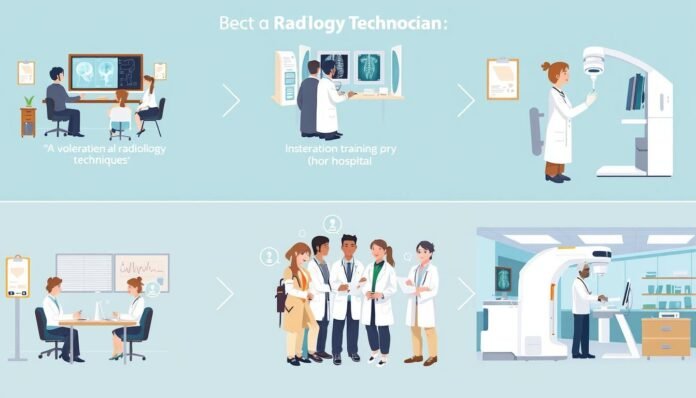A career as a radiology technician can be gratifying. This guide will help you become a skilled medical imaging pro.
We’ll cover the steps from understanding the job to education and career growth. You’ll get the info you need to reach your goals.
A detailed illustration of the step-by-step journey to becoming a radiology technician, featuring a series of scenes: 1) a classroom with students studying anatomy and radiographic techniques, 2) a hands-on training session in a medical lab with imaging equipment, 3) an internship setting in a hospital, showcasing teamwork among healthcare professionals, 4) a graduation ceremony with students in lab coats holding certificates, and 5) a modern radiology department with advanced imaging machines and a tech at work. Each scene seamlessly transitions into the next, depicting radiology’s educational and professional growth.
Radiology techs, or radiographers, are key in healthcare. They use special equipment to take pictures inside the body.
These images help doctors find and treat health problems. Radiologists then study the pictures to make diagnoses.
This guide will help you start a career in radiology. You can work in hospitals, clinics, or imaging centres.
Understanding the Role of a Radiology Tech
Radiology technicians operate medical imaging equipment to capture detailed body images. They use X-rays, CT scans, and MRI machines to help doctors diagnose and treat patients.
These professionals position patients and adjust equipment for high-quality images. They also follow radiation safety protocols to protect everyone involved.
Radiology technicians work closely with radiologists to provide necessary information. They need strong technical skills to operate complex imaging machines effectively.
Good communication skills are essential for radiology technicians. They must explain procedures and put patients at ease during imaging.
Their work is crucial for accurate diagnosis and treatment, and radiology technicians play a vital role in improving patient outcomes.
Educational Requirements for Radiology Techs
To become a radiology tech, you need specific education. High school students should focus on science, math, and tech classes.
Many programs require courses like anatomy, physics, and computer science. These help build a strong foundation for future studies.
Radiology tech programs offer associate’s or bachelor’s degrees. Associate’s degrees take two years and cover basics.
Bachelor’s degrees provide more in-depth training. They often include extra courses in patient care and healthcare management.
Choose an accredited school for your radiology tech education. This ensures you get proper training and hands-on experience.
Accredited programs help you qualify for certification and licensure. These show your skill and dedication to the field.
Finding the Right Radiology Program
Choosing a top radiology tech program is vital for your healthcare career. Research your options carefully to find the best fit for you.
Look for accredited schools with solid curriculums and hands-on training. Community colleges often offer associate’s degrees in radiologic technology.
Four-year universities provide bachelor’s and master’s programs in radiology for advanced studies.
When picking a program, consider program length, clinical experience, and ARRT exam pass rates. Job placement rates are also significant.
Online courses offer flexibility but should meet high-quality standards. Choose a program that fits your needs and career goals.
By weighing the pros and cons, you’ll find the perfect program. This will help you start a rewarding career as a radiology tech.
Financial Planning for Your Education
Becoming a radiology tech requires careful financial planning. Program costs vary widely, from $20,000 to $40,000 for a two-year associate’s degree.
Financial aid can make your education more affordable. Scholarships, grants, and loans are available for medical imaging students.
Many programs offer scholarships for aspiring radiology techs. The Federal Pell Grant provides funds you don’t need to repay.
Student loans can help cover the remaining costs. Remember to budget for textbooks, uniforms, and equipment, too.
With proper planning, you can achieve your radiology tech dream. Explore all funding options to make your education possible.
Completing Your Radiology Degree
Becoming a radiology tech requires a thorough education. The curriculum mixes classroom learning with hands-on experience.
Students take courses in human anatomy and medical imaging techniques. They also learn about radiation safety and patient care.
These studies prepare students for real-world clinical experience. This experience is key to developing the necessary skills.
Clinical experience is vital in radiologic technology programs. Students work with experts in hospitals, clinics, and imaging centres.
This training lets students apply their knowledge in supervised settings. Graduates can perform various procedures with confidence.
Students can build their professional network during their studies. They gain insights from industry experts and find internship opportunities.
This whole educational experience prepares students for success. They can thrive in this exciting and rewarding field.
Obtaining Certification and Licensure
Getting certified is key for aspiring radiology techs. The ARRT offers top-notch certification in radiology.
The ARRT exam tests patient care and radiation protection skills. Passing it earns you respected ARRT certification.
Many states require radiology techs to have a license. Check your local rules to meet all requirements.
Radiology technician standing confidently in a modern medical imaging room, surrounded by advanced imaging equipment like an MRI machine and X-ray unit, with a certification badge prominently on a lab coat, bright lighting, and a sleek and high-tech environment.
Licensing processes differ by state. You may need to apply and show proof of education.
ARRT certification and a background check are needed. These steps show your dedication to safe practice.
Getting certified can seem harsh, but good prep helps. Stay focused on your goal of helping patients.
With hard work, you’ll earn the credentials you need. Your impact on healthcare will be worth the effort.

Gaining Experience in the Field
New radiology tech grads need hands-on experience for career growth. Internships and entry-level jobs offer chances to apply knowledge and develop skills.
Internships let you explore different radiology specialities. You’ll work with pros and learn about the industry.
Many programs and healthcare facilities offer internships. Look for ones that match your interests and goals.
After an internship, seek an entry-level radiology job. These roles help you grow and refine your skills.
Look for jobs with growth chances and diverse patient populations. Keep learning to boost your skills and open new doors.
Pursue more certifications and attend industry events. Stay current with the latest radiology tech advances.
Advancing Your Career as a Radiology Tech
Radiology techs have many chances to grow in their field. You can specialize in different areas of medical imaging.
Expand your skills by getting more certifications. Try advanced training in CT, MRI, or mammography.
Leadership roles can be a significant next step. You could become a clinical supervisor or department manager.
Keep learning to advance in medical imaging. Join professional groups and stay up-to-date with new tech.
Navigating the Job Market
Create a strong resume for your radiology tech job search. Highlight your education, certifications, and experience in medical imaging.
Prepare for interviews by researching potential employers. Practice answering common radiology tech questions.
Network at industry events and join professional associations. Connect with healthcare professionals on LinkedIn for job leads.
Stay updated with the latest trends in medical imaging. Pursue professional development to show your commitment to the field.
With a strategic approach, you can find your ideal radiology tech role and build a strong personal brand to stand out in the job market.
Understanding Salary and Job Outlook
A career as a radiology tech can be fulfilling and financially stable. The average U.S. radiology tech salary is about $60,000 per year.
Actual salaries vary based on experience, location, and workplace. The job outlook for radiology techs is bright.
The medical imaging field is growing fast. It’s expected to grow 9% over the next decade.
This growth comes from an ageing population and new medical technology. There are many job options in hospitals, clinics, and imaging centres.
Knowing salary and job outlook helps in career planning. Staying current on trends can boost your earning potential.
You can build a great career in the exciting world of medical imaging. It’s a fast-paced field with many opportunities.
Balancing Work with Personal Life
Radiology techs face challenges in maintaining a healthy work-life balance. The healthcare industry often demands long hours and high-stress environments.
Effective stress management is key for work-life balance. Relaxation techniques like meditation or yoga can help reduce work-related stress.
Regular breaks and physical activity are essential for overall well-being. Prioritizing self-care activities can also help maintain a healthy balance.
It is crucial to set clear boundaries between work and personal life. This means learning to say no to extra work when needed.
Making time for family, friends, and hobbies is essential. It helps avoid burnout and keeps radiology techs engaged in their careers.
A good work-life balance helps radiology techs thrive. Prioritizing self-care and managing stress ensures a rewarding career in radiology.
The Future of Radiology Technology
Radiology is changing fast with exciting new advances. AI and machine learning will change how medical imaging works.
These tools will improve diagnosis accuracy, patient care, and smoother workflows for radiology techs.
The future of medical imaging focuses on personalized medicine. Advanced imaging can be custom-made for each patient’s needs.
Radiologists will collaborate with doctors to create special treatment plans using high-quality scans and smart data analysis.
New portable imaging devices will be a big part of radiology’s future. These tools will bring diagnostic services to remote areas.
Patients will get care no matter where they live, and radiology techs will pioneer new healthcare solutions.
FAQ
What are the typical responsibilities of a radiology tech?
Radiology techs operate medical imaging equipment, such as X-ray, CT, and MRI machines. They capture high-quality images to help diagnose and treat medical conditions.
They also care for patients and explain procedures. Ensuring the safety of patients and staff is another key duty.
What educational path do I need to become a radiology tech?
You’ll need an associate’s or bachelor’s degree in radiologic technology. These programs cover anatomy, physiology, patient care, and medical imaging equipment operation.
Supervised clinical rotations are also part of the training.
How do I choose the right radiology tech program?
Look for accreditation, reputation, clinical affiliations, and alignment with your career goals. Check the curriculum, hands-on training, and job placement rates.
This will help ensure the program meets your needs.
What is the certification process for radiology techs?
After completing an accredited program, pass the ARRT certification exam. Many states also require a license to practice.
What is the job outlook for radiology techs?
The job outlook is positive. The BLS projects 9% growth from 2020 to 2030.
An ageing population and tech advances drive demand for medical imaging services.
How can I advance my career as a radiology tech?
Specialize in a specific imaging modality or pursue leadership roles. Getting additional certifications can also boost your career.
Continuing education helps you stay current with industry trends and practices.
You may also read: How Long Does It Take to Become an Ultrasound Tech
